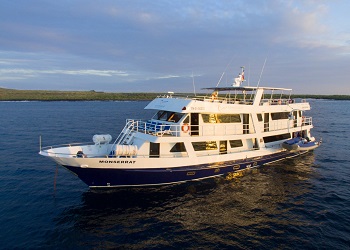Coral I&II Itinerary A - 4 Days
ITINERARY A - 4 DAYS
SUNDAY
AM: Baltra Arrival and Transfer to the Boat
PM: Santa Cruz: Carrion Point (PR)
MONDAY
AM: Genovesa: El Barranco, Prince Philip ́s Steps (HK/KY/SN)
PM: Genovesa: Darwin Bay (HK/KY/SN/PR)
TUESDAY
AM: Rabida Island (HK/KY/SN)
PM: Bartolome Island (HK/PR/SN)
WEDNESDAY
AM: Santa Cruz: Highlands Tortoise Reserve (HK)
AM: Baltra: Transfer to the Airport
HK: HIKE / SN: SNORKEL / PR: PANGA RIDE / KY: KAYAK /
PB: PADDLE BOARD
DAY 1: SUNDAY
AM: BALTRA ARRIVAL AND TRANSFER TO THE BOAT
Departure from either Quito or Guayaquil to Baltra Island is a 2 ½ hour flight. Upon arrival in the Galapagos, passengers are greeted at the airport by our knowledgeable guides who will accompany them on a short ten-minute bus ride to the pier where they will board the Coral I or Coral II
PM: SANTA CRUZ: CARRION POINT
Dinghy ride at the entry of the Itabaca Channel in a lagoon with turquoise water, where we can observe sharks, blue-footed boobies, and different kinds of fish.
DAY 2: MONDAY
AM: GENOVESA: EL BARRANCO / PRINCIPE PHILL`S STEPS
Be marveled at the variety of sea life that uses the crevices of the lava cliffs for shelter. Red-billed Tropicbirds fly overhead, and a mall colony of fur seals may be found near the landing site. You will be dropped off at a steep stairway that begins on rocks at the foot of a path that leads through a seabird colony full of Nazca and Red-footed Boobies
PM: GENOVESA: DARWIN BAY
From within the flooded caldera of Tower Island, we set foot onto a sandy beach to be greeted by swallow-tailed gulls often said to be the most beautiful gull in the world. In the trail we can see at nesting red-footed boobies and great frigatebirds.
DAY 3: THUESDAY
AM: RABIDA ISLAND
Lying at the archipelago's heart, this dramatic island with a distinctive red-sand beach is home to sea lions, mockingbirds, finches, endemic Galapagos doves, and vermilion flycatchers. A walk takes us through a forest of palo santo and cacti to a beautiful overview of the bay.
PM: BARTOLOME ISLAND
Considered the most iconic landscape of the entire archipelago the view from the top of Bartolome Island, overlooking the famous Pinnacle Rock and the austere Santiago Island, Our subsequent snorkel here might put us face to face with Galapagos penguins, white-tipped reef sharks, and playful sea lions.
DAY 4: WEDNESDAY
AM: SANTA CRUZ: HIGHLANDS TORTOISE RESEARCH / BALTRA TRANSFER TO THE AIRPOT
In the Highlands of Santa Cruz Islands, we have our best opportunity to interact at close quartes with totally wild.
Galapagos giant tortoise. A short walk among these huge 600Lb reptiles will also offer the chance for more highland species, especially several species of the famed finches.
After the visit, passengers will be transferred to, the airport for their return flight to Guayaquil or Quito.







